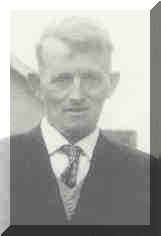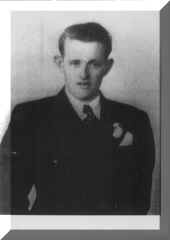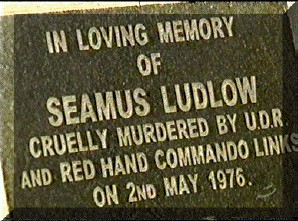The Murder of Seamus Ludlow in County Louth, May 1976. Towards a public inquiry?



The Murder of Seamus Ludlow in County Louth, May 1976. Towards a public inquiry?
|
|
Introduction to the murder of Seamus Ludlow and the official cover-up. Michael Cunningham investigation - 1978 The recent Campaign for Truth and Justice. Irish Victims Commission Report. Ludlow family's questions for the RUC (now the PSNI) Jim J. Kane's letter to the N I Human Rights Commission. Jim J. Kane's letter to the RUC Ludlow Family Letter to Bertie Ahern View messages from our original Guestbook Other Ludlow Family Sites.
|
The Sunday Independent, 2 November 2003:
JOE TIERNAN LAST Wednesday, the long-awaited report into the worst atrocity of the troubles - the 1974 Dublin and Monaghan bombings, which killed 33 people and injured almost 300 - was presented to the Taoiseach by its author, Justice Henry Barron. Within the next two weeks, Bertie Ahern will present it to his Cabinet colleagues and then to the joint Oireachtas Committee on Justice, Equality and Women's Rights. It's believed a heavily edited version will later be passed to the Justice for the Forgotten group, which represents the victims' families, and this version will be published later. The findings of the report (estimated to be almost 300 pages long) will have far-reaching implications not just for the authorities here - most particularly the Gardai who failed to track down the perpetrators - but also for the British, whose security forces are firstly accused of involvement and, secondly, of failing to cooperate with the Gardai during the 1974 investigation. And for the relatives of those killed as well as those injured, the report marks another milestone in their 29-year quest for justice. The enquiry, led first by Judge Liam Hamilton, who died shortly after assuming his duties, and latterly by retired Supreme Court Judge Henry Barron, has taken 46 months and cost in excess of €1.5m. In the course of the enquiry, investigators have been delving into the goings-on between loyalist paramilitaries and their undercover allies in the various branches of security forces during the 1970s. And it's not just Dublin and Monaghan which came under the microscope. At the behest of relatives and other interested groups, Barron widened his remit to include a raft of other contiguous events; most notably the Dublin bombings of 1972 and 1973, the Dundalk bombing of 1975, the murders of John Francis Green in Monaghan, in 1975 and Seamus Ludlow in Dundalk, in 1976. In all, 48 people were killed and almost 400 others injured by loyalist paramilitaries south of the border during the troubles. Yet not a single individual has been convicted of any of these murders. Today relatives of the victims say this is a scandal and point to the glaring disparity between the success of the British police against Republicans operating on the mainland during the same period and the "abysmal failure" of the Garda to apprehend loyalists operating down here. So will there be justice at the end of it all? Many of the families are both sceptical and cynical. "It was too long ago, many of the killers are now dead and I simply don't believe the Irish government has either the bottle or the evidence to see
'48 people were killed south of the border, yet not a single individual has been convicted of any of these murders'
this thing through. It's not like Omagh. Omagh was just recently," says Jim Sharkey whose uncle was abducted and murdered by loyalists north of Dundalk in 1976. From the outset, the enquiry was faced with an invidious task - where to draw the line? Should it enquire into all 48 murders or should it stick to its original terms of reference, Dublin and Monaghan 1974? In the end, Judge Barron appears to have opted for the middle road: to enquire into those cases about which he has been petitioned by families of those killed and injured. The end result may prove unsatisfactory as families of a number of "excluded" victims have already voiced their concerns. Anthony Reilly, from Belburbet, Co Cavan, whose 15-year-old sister was killed in an explosion in the town centre in 1972, says no one asked them if they wished to be included. "We have been left to suffer our loss here for 31 years and no one, not even the Gardai, came near us to tell us what happened. It's just not good enough," he said. Seventy-four-year-old Anna Mone from Castleblayney, whose husband was killed in an explosion in the town in 1976, says she has petitioned the government for the last four years but she has not been included. So what has Barron unearthed then? According to sources close to the enquiry, the report does not paint a pretty picture. Allegations of British Army and Special Branch involvement, Garda bungling during the investigation, contamination of forensic evidence, lack of RUC cooperation, and perhaps the most serious charge of all - failure of Garda management to keep the government of the day informed of the crisis. On the operational side, the evidence presented to Barron states, among other things: 1. The bombings were planned by the UVF leadership in Belfast, Lurgan and Portadown throughout the latter months of 1973 and in early 1974 and were deliberately timed to coincide with the 1974 UWC strike which brought down the power-sharing Sunningdale Agreement. 2. A team of up to 20 loyalists (mainly UVF but also some UDA men) travelled south to execute the two operations on the day, May 17 1974. 3. The team was led by Billy Hanna and Robin Jackson from Lurgan and Wesley Summerville from Moygashel, Co Tyrone (all of whom, bar Hanna, were involved in the Miami Showband ambush north of Newry 14 months later). Hanna and Jackson were run as agents by a team of British Army Intelligence Officers based at Army HQ in Lisburn. It is these officers, whose names are known to the Sunday Independent, who are accused of plotting the attacks. 4. The Dublin bombs were assembled and stored at a farmhouse in a loyalist area of South Armagh and were transported by Jackson and Hanna to the car park of the Coachman's Inn pub on the Swords road near Dublin Airport on the morning of the attacks. Later that day they were 'wired up' by Hanna and loaded into three separate cars where loyalists drove them to the city centre. (The car park had been used by traders for decades previously who thronged it with vans and lorries each Friday hawking and peddling goods. It provided the ideal cover for loading the bombs). 5. The grounds of the nearby Holy Child Catholic Church at Collins Avenue, Whitehall, was also used as a transit point for the bomb cars and the getaway cars. 6. Each bomb car was preceded by a scout car from the car park to its destination. The scout car was then used in the getaway. 7. All Dublin bombers escaped by fleeing through the city centre and crossing the border near Hackballs Cross in Co Louth before 7.30pmapproximately. 8. The Monaghan bomb, which exploded 90 minutes after the Dublin bombs, was designed to "pull gardai away" from the Hackballs Cross area, leaving a gap to allow the Dublin bombers to cross. 9. The Monaghan bomb was organised from Armagh and the operation was led by a notorious UVF commander from Portadown who drove the bomb car into the town. He is now hiding in Scotland. Throughout the four-year investigation, the enquiry team has been trawling through the entire 1974 Garda file. A number of scientific studies of the bombings by military and explosives experts have also been commissioned by Barron's team. However, the main goal (and the main stumbling block) of the enquiry has been to try to assemble enough hard evidence to prosecute named suspects, still living. If such evidence is deemed by the Dublin authorities to be in the report, then extradition warrants for the arrest of the suspects will be prepared. The suspects - some are still in Northern Ireland, others are living in England or Scotland - would then be handed over to the Garda. So who has Barron interviewed then? Pretty well just about everyone who matters in this tragic, evanescent story: from former government ministers to retired Garda commissioners, to gardai who collated evidence on the streets, to witnesses who allegedly saw suspicious activity on the day. He has also met a number of officials from the British side including Dr John Reid, during his term as Northern Secretary. Barron is anxious to extract from the British as much information as possible about the bombings, but according to all accounts, cooperation has been less than full. Former RUC files have been reopened but the shutters have come down on the sensitive subject of collusion. Bertie Ahern said recently that while information had been provided by the British, it would be foolish to believe that "all had been received". Another of the problems Barron has faced is that the 1974 investigation was almost exclusively a Garda one, because the offences were committed in the south. At the time, police in Belfast and Armagh interviewed a number of witnesses, including some people whose cars had been stolen but the old RUC files are believed to be scant. Also adding to Barron's woes is the fact that most of the senior Garda officers who worked on the 1974 investigation are now dead. However, one important figure, still alive and who travelled to Government Buildings where Barron and his team are based, is retired Detective Inspector Colm Browne, who spent most of his police career on the border. A Protestant from County Wicklow, Browne was known as a "super investigator" who spearheaded many of the major murder hunts in the 1970s including the murder of Captain Robert Nairac in 1977. In 1974 Browne and the head of the murder squad, Dan Murphy (now dead) visited Tenant Street RUC station in the Shankill, but were refused cooperation by the RUC. Dan Murphy later told colleagues that the reception he and Browne received was so hostile that the two men feared for their lives. Sharp criticism of the Garda in Barron's report is believed to centre on a number of key operational areas during the initial year-long investigation in 1974/75. Chief among them was the failure of the Technical Bureau to preserve scientific evidence collected from the bomb scenes and a six-day delay in sending it to the Science Laboratory which, ironically, at the time happened to be in Belfast. In a report, seen by the Sunday Independent, the head of the Science laboratory in Belfast at the time, Dr Hall criticised, among other things, the delay, saying ". . . identification of the explosives used can be achieved providing the correct samples are received within six hours". So where do we go from here? Following the report's publication, the Oireachtas Committee will hold public hearings before issuing its own report. In this, the Committee will make recommendations to the Government on further action. If evidence against British security forces is compelling, then there is little doubt that the government will come under intense pressure to establish a full judicial public inquiry where witnesses will be compelled to give evidence under oath - unlike the Barron enquiry where information given was voluntary. However, the cost and duration of the other tribunals at Dublin Castle will weigh against such a prospect. Joe Tiernan is author of The Dublin and Monaghan Bombings and The Murder Triangle which will be published shortly. The Dundalk Democrat, 21 December 2002: Author identifies those who may have been responsible Book on bombing to be launched on Saturday The Dundalk Democrat, 21 December 2002: Nearly 30 years on from Dundalk bombing and the fight for justice continues The Dundalk Democrat, 04 January 2003: A photograph of Joe Tiernan's book launch in Dundalk. (See above Dundalk Democrat 21 December 2002) The Sunday Times, January 12, 2003: Army 'link' to Dublin bombings RM Distribution, 13 January 2003: Dublin/Monaghan bombs came from British Army - report Sunday Business Post, 19 January 2003: Dublin-Monaghan: will the truth finally out? Ulster Television News online, 27 February, 2003: Irish justice group 'furious' over Barron Inquiry The Irish Examiner online edition, 27 February 2003: Group calls for new Dublin-Monaghan bombings inquiry The Irish News, 5 March 2003: Family's wait for murder file over The Dundalk Democrat, 8 March 2003: Ludlow murder: files to be made available The Irish News, 11 March 2003: Family 'cautious' over inquest progress The Dundalk Democrat, 15 March 2003: Plaque to Patrick Mone unveiled The Irish News, 21 March 2003: Loyalist murder inquiry call renewed The Irish Sun, 26 March 2003: Report on Ludlow to be unveiled The Daily Irish Star, 26 March 2003: Inquiry into man's murder The Irish News, 27 March 2003: Government 'will not keep Ludlow secrets' The Irish Times, 13 June 2003, Inquest on 1974 Dublin bombs to reopen The Irish Independent, 13 June 2003: Victims and families a step nearer the truth Dundalk Democrat, 28 June 2003: Dundalk families concerned over Barron report delay The Sunday Business Post, 29 June 2003: Irish government `helped the British' during Troubles The Irish Independent, 22 July 2003: AG is urged to reopen inquests into bomb deaths The Examiner (formerly The Crossmaglen Examiner), 5 August 2003: Victims' families demand truth about collusion The Dundalk Democrat, 16 August 2003: Date for Ludlow inquest The Irish News, 7 October 2003: Coroner still awaiting copy of murder report Ireland on Sunday, 12 October 2003: Top names linked to Dublin-Monaghan atrocity Bombs report names gardai 'collaborators' I Homepage I I Top
I I Press Coverage I I Barron
Inquiry I I Terms of reference for Barron
Inquiry I I Fresh Inquest I I Celtic
League Support I I New
GuestMap Guest Book.
I
Copyright © 2003 the Ludlow family. All rights reserved. Revised: November 07, 2003 .
|